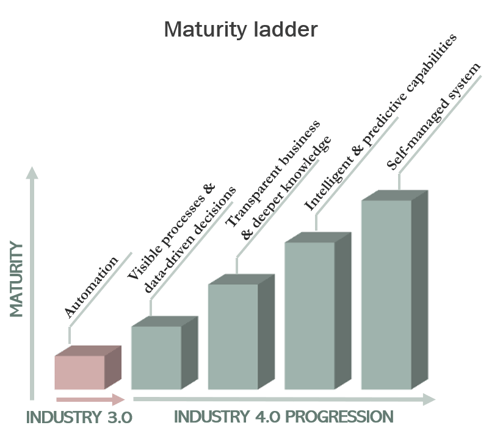Industry 4.0 was first introduced in Germany in 2011. Ten years later, the envisioned “Fourth Industrial Revolution” has not yet truly happened. Or at least progress has been slower than you would expect. Industry 4.0 maturity is still low in many organizations and the gap is increasing to those that have invested in the needed new technologies.
We wanted to know why Industry 4.0 maturity is low
From our experience in different kinds of digital transformation projects and from dialogues with leaders in the manufacturing industry sector, we have learnt that the low level of Industry 4.0 maturity is a growing problem for many organizations. Expectations on achieving new business benefits is constantly increasing, while investment decisions and the needed transformations don’t progress with the same required pace. You don’t necessarily have to call it “Industry 4.0”. Some would instead talk about “smart manufacturing”, “the intelligent enterprise” or “digitalization” in more general terms. However, in this blog article we will use the term “Industry 4.0”.
For looking more closely into the hypothesis of a low level of Industry 4.0 maturity, we contacted and interviewed a set of relevant technology and solution providers. Nine leading companies on the Swedish and European market were interviewed. These solution providers all confirmed the hypothesis in one way or another. The solutions they provide today primarily focus on improving overall equipment effectiveness (OEE) and transparency in the manufacturing processes. This is made possible by collecting, visualizing and analysing manufacturing related data through their solutions and related technologies. Their customers are generally not yet in a position where they request more intelligent or predicting capabilities. The requested solutions are often implemented in isolation rather than in an end-to-end manner.
Many organizations are stuck with slow progress on a low level of maturity
By breaking down the Industry 4.0 transformation into levels of maturity, we can more easily understand what steps organizations need to take to develop their Industry 4.0 capabilities. Industry 3.0 focused on computerizing and automating production processes as much as possible to increase productivity. The fourth industrial revolution aim to connect machines, systems, and people and subsequently to develop autonomous businesses. The model below illustrates four levels of maturity for Industry 4.0 progression.

The maturity model above is based on Industrie 4.0 Maturity Index, Acatech, 2018.
The model includes four levels of Industry 4.0 maturity
Each level of maturity is associated with new sets of capabilities and business benefits that become enabled through the transformation that is supported by the Industry 4.0 related technologies and solutions.
Level 1 Visible processes & data-driven decisions: Understanding what is going on right now in operations, i.e. gathering information from machines and systems in order to visualize the results and enabling people to make data-driven decisions rather than experience-based decisions.
Level 2 Transparent business & deeper knowledge: Using the accessible information to understand why previous and present events have happened, in order to get a deeper grasp of the complete system and its complexity. An example could be to have end-to-end visibility of how certain delayed purchase order deliveries cause a certain set of sales orders to be pending.
Level 3 Intelligent & predictive capabilities: Next level of analytics where data and event patterns are analysed, and predictive models and algorithms are designed to give future insights such as sending alerts to the production manager when it is likely that a future event will happen. Acting on this information can optimize resources and processes, avoid productions stops and foresee demand.
Level 4 Self-managed system: The connected ecosystem makes self-optimizing decisions based on fully accessible information, probabilities of events, self-taught insights and self-adapting capabilities. An example could be auto-generated purchase orders for certain raw materials based on auto-generated insights about an expected seasonal increase in demand on a certain customer’s market.
Many are laggers – still working on the first level of Industry 4.0 maturity
After discussing with manufacturing organizations and the interviewed solution providers, we realize that many are still stuck working on Level 1 of their Industry 4.0 maturity. The solutions and technologies implemented enable them to gather, organize and visualize data for a certain area of their business, so that decisions and corrective actions can be made. In many cases there is some logic built into how the data is organized, such as automated alarms if certain thresholds are hit. However, solutions are rarely integrated end-to-end and these organizations have not yet started to get intelligence from combined data sets from different parts of their business. One could claim these organizations are lagging behind in their Industry 4.0 maturity and progression. They are laggers.
There are many obstacles that laggers will have to overcome
We have identified a few obstacles that lagging manufacturing organisations are facing during their Industry 4.0 progression. Some of these obstacles are:
-
-
-
-
-
-
-
-
-
-
-
-
-
Culture: the manufacturing industry has a heritage of being conservative and having a “we do as we always have done” approach. In the end, organizations with this type of attitude will not prevail in the competition.
-
-
-
-
-
-
-
-
-
-
-
-
-
Insufficient decision-making: lack of knowledge and understanding in the area, in combination with making insufficient business cases, result in lack of the needed investments decision-making. If the investments decisions are not made, maturity will naturally remain low.
-
Wrong focus: many manufacturing organizations get stuck on technical and security related issues when exploring Industry 4.0, instead of focusing on potential value creation.
-
-
Gap between IT and OT: the IT department and OT (operations technology) department often have difficulties in coming together, with regards to integration of both technologies and people, which will prevent them from achieving true end-to-end Industry 4.0 progress.
Overturning these obstacles will be key for laggers to progress to higher levels of maturity. However, there are some manufacturing organizations that have started to progress in maturity several years back and today they have reached higher levels of maturity. We denote them as adopters. Adopters have for instance managed to:
- Optimize production through simulation enabled by digital twin
- Intelligently and predictively automate production and maintenance
- Achieve world-class productivity enabled by several smart technologies
- Ensure end-to-end connected data flow and integrated intelligence about assets
In our upcoming part 2 blog article, we will delve more into what these adopters have achieved and explore what is required for laggers to succeed.
If you want to know more about our view on Industry 4.0 and the manufacturing industry, or how we help clients in managing transformation, feel free to contact the authors Jonas Ekman and Mattias Magnusson (see contact information below).
About Centigo
Centigo is a management consulting company with many years of experience in cross-functional business development and digitalization. Within the manufacturing industry we help companies with, among other things, strategy formulation, process development, evaluation and introduction of digital tools and solutions as well as change management.

Jonas Ekman
Advisor and project manager in digitalization for the manufacturing industry

Mattias Magnusson
Management consultant in digitalization and transformation


